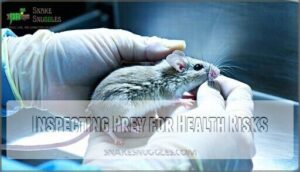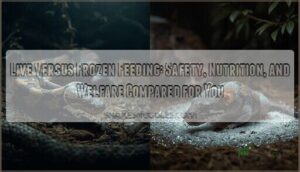This site is supported by our readers. We may earn a commission, at no cost to you, if you purchase through links.
 You’ve probably heard "snake diet" thrown around as a weight loss trend, but hold on—this isn’t about feeding pythons. The human Snake Diet promotes extreme fasting cycles that mimic how snakes eat infrequently, sometimes going days or weeks between meals.
You’ve probably heard "snake diet" thrown around as a weight loss trend, but hold on—this isn’t about feeding pythons. The human Snake Diet promotes extreme fasting cycles that mimic how snakes eat infrequently, sometimes going days or weeks between meals.
While actual snakes thrive on this pattern because their biology is built for it, humans operate on completely different metabolic principles. Understanding why snakes eat the way they do—and why their nutritional needs differ drastically from ours—reveals exactly why copying their eating patterns can backfire.
Before you consider any extreme fasting protocol, you need to know what happens when human bodies don’t get regular nourishment.
Table Of Contents
Key Takeaways
- The Snake Diet promotes extreme fasting cycles (24-72 hours between meals) that mimic snake eating patterns, but humans need consistent nourishment and can’t safely adopt reptilian metabolism.
- Extended fasting causes serious health risks, including electrolyte imbalances, dehydration, cognitive impairment, a 91% higher risk of heart-related death, and nutrient deficiencies that damage bones, muscles, and nerves.
- Pet snakes need whole prey (not human-prepared meat) to get complete nutrition, including calcium and vitamin D3, with prey size matching 1.5 times their girth and feeding frequency of 7-14 days for adults.
- Safe weight loss requires balanced nutrition with moderate calorie reduction (500 kcal daily), adequate protein and vegetables, regular exercise (150-300 minutes weekly), and professional guidance from registered dietitians instead of extreme fasting protocols.
What is a Snake’s Natural Diet?
Before you stock your enclosure or plan feeding schedules, you need to understand what snakes actually eat in nature. Their diet shapes everything from nutritional requirements to feeding behavior.
Let’s look at what makes up a healthy snake diet in the wild.
Common Prey Types in The Wild
In the wild, snakes don’t browse a menu—they hunt whatever moves, from warm-blooded rodents and birds to cold-blooded frogs, lizards, fish, and even insects, depending on their size and habitat. This snake diet diversity reflects their adaptability across ecosystems, with each snake species evolving unique preferences based on availability and hunting ability.
Common prey types include:
- Amphibians and Reptiles – Frogs, toads, and lizards fuel many small to medium snake species
- Bird Consumption – Eggs and nestlings provide protein-rich meals for arboreal hunters
- Insectivores – Smaller snakes target beetles, crickets, and other invertebrates
- Fish Diets – Aquatic snakes thrive on fish, sometimes practicing cannibalism on smaller snakes
Nutritional Needs of Snakes
What snakes eat matters less than what they absorb—and that’s where whole prey becomes a non-negotiable cornerstone of their survival. As obligate carnivores, snakes depend on complete nutrition from intact animals, which deliver balanced calcium, vitamin D3, and protein through natural prey digestion.
This whole-package approach ensures proper calcium balance and water intake without supplements, meeting the essential nutrients for snakes that captive diets must replicate for peak snake nutrition.
Diet Differences Among Species
Not every snake shares the same appetite—some species have spent millions of years perfecting their taste for fish, birds, or even eggs, while others won’t touch anything beyond furry rodents. These species-specific diets reflect habitat impact and prey availability in their natural environments.
For instance, garter snakes thrive on fish and amphibians, while ball pythons stick exclusively to small mammals. Understanding these dietary adaptations and species variations ensures you’re feeding your snake according to its evolved digestive systems and age-specific diet guidelines.
How to Feed Pet Snakes Safely
Feeding your pet snake the right way isn’t complicated, but getting the basics wrong can lead to serious health problems. The key is matching prey size to your snake’s body, offering nutritional variety, and choosing the safest feeding method.
Let’s break down what you need to know to keep your snake healthy and well-fed.
Choosing The Right Prey Size
Getting the prey size right isn’t just about eyeballing it—it’s the difference between a healthy meal and a trip to the vet. You’ll want to measure your snake’s girth at its widest point, then choose prey no larger than 1.5 times that thickness.
A prey size chart helps you scale appropriately as your snake grows. Oversized meals trigger regurgitation and health risks, while undersized prey won’t support metabolic health or prevent weight loss.
Prey Variety for Balanced Nutrition
Think of prey variety like a multivitamin—offering different rodent types throughout the year keeps your snake’s nutrition balanced and prevents deficiencies from creeping in. Rotating between mice and rats provides varying rodent nutritional profiles, while alternative prey options like chicks or quail add enrichment through diet.
Gut loading prey before freezing boosts nutritional value, reducing supplementation concerns and supporting prime snake nutrition without creating imbalances.
Frozen-Thawed Vs. Live Prey
Regarding feeding your snake, should you reach for frozen prey or risk a live feeding? Frozen-thawed prey is the ideal choice—it eliminates management risks, prevents injuries to your snake, and considers ethical issues around live prey suffering. Here’s why it wins:
- Safety first: Live prey can bite or scratch, causing serious wounds
- Prey availability: Frozen options are consistent and convenient year-round
- Cost comparison: Buying frozen in bulk saves money long-term
Nutritional differences between frozen-thawed and live prey are minimal when treated correctly.
Preparing and Offering Prey Correctly
Getting your snake’s meal ready isn’t just about tossing frozen prey into the enclosure. Safe preparation protects both you and your snake from potential risks.
Here’s how to work with prey the right way.
Safe Thawing and Warming Methods
Thawing frozen prey the right way isn’t just about convenience—it’s about keeping your snake safe from bacterial infections and digestive problems.
Place frozen-thawed prey in the refrigerator for 12-24 hours, never at room temperature where bacteria multiply fast. Once thawed, warm it gently in a sealed bag submerged in warm water for 10-15 minutes. Always check the prey’s core temperature with your hand—it should feel slightly warm, not hot or cold.
| Method | Best Practice |
|---|---|
| Thawing Timeframes | Refrigerate 12-24 hours overnight |
| Warming Techniques | Sealed bag in warm water 10-15 minutes |
| Temperature Monitoring | Feel prey—should be slightly warm |
| Bacteria Prevention | Never thaw at room temperature |
| Safety Precautions | Use tongs; wash hands after use |
Inspecting Prey for Health Risks
Before you hand over that frozen mouse, take a close look—spoiled or damaged prey can turn feeding time into a health disaster. Check feeder animals for visible injuries, discoloration, or foul odors that signal bacterial contamination.
Proper sourcing from reputable suppliers reduces parasite detection risks. Careful attention and regular health checks protect your snake from serious health problems during secure feeding.
Using Feeding Tools and Techniques
Feeding tongs are your best friend here—they keep your hands out of striking range and teach your snake to recognize prey instead of fingers. Here’s how to nail safe feeding:
- Choose tongs vs. forceps based on your snake’s size—longer tools work better for larger species
- Use gentle movements to reduce stress and mimic natural hunting behavior
- Practice bite prevention by never hand-feeding and maintaining consistent feeding schedules
- Clean tools after each use to follow proper hygiene practices and prevent bacterial spread
Key Health Risks From Poor Snake Diets
When your snake isn’t getting the right nutrition, the consequences can sneak up on you. Poor feeding practices create real health problems that range from mild deficiencies to life-threatening conditions.
Let’s look at the most common nutritional issues you need to watch for.
Metabolic Bone Disease and Vitamin Deficiencies
When a snake’s diet falls short on calcium or vitamin D3, the consequences show up in their bones—literally. Metabolic bone disease develops when dietary ratios miss the mark, causing soft bones, tremors, and deformities. Calcium absorption depends heavily on vitamin D3, and bone health suffers without it.
While UV lighting helps some species, most captive snakes rely on whole prey for proper bone structure. D3 supplementation isn’t usually needed when you’re feeding appropriate prey, but calcium deficiency can creep in if you’re not paying attention.
Obesity, Underfeeding, and Weight Issues
Getting the food balance right isn’t always easy—snakes can end up carrying too much weight or wasting away if you’re not watching closely. Obesity signs include visible fat deposits and reduced mobility, while underfeeding risks stunted growth and muscle wasting.
Regular weight assessment and body condition checks help you catch problems early, ensuring your snake maintains healthy growth without rapid weight loss or excessive weight gain that compromises long-term health.
Recognizing Signs of Nutritional Imbalance
Beyond the obvious red flags like weight problems, your snake might be dealing with nutritional issues that show up in sneakier ways—think dull scales, lethargy that doesn’t match their feeding schedule, or recurring health problems that seem to come out of nowhere.
Watch for shedding problems, unusual stool, or sudden appetite changes. These signs often point to vitamin deficiencies or electrolyte imbalances that need immediate attention to prevent serious health risks down the road.
Is The “Snake Diet” Safe for Humans?
You’ve probably heard whispers about the "Snake Diet" and wondered if mimicking a snake’s eating pattern could work for humans. The short answer is no—this extreme fasting protocol carries serious health risks that far outweigh any potential benefits.
Let’s break down exactly how this diet works and why medical professionals warn against it.
How The Snake Diet Works
The Snake Diet breaks down into three distinct phases, each pushing your body further into extended fasting territory. You start with a detox period of 24 to 48 hours, drinking only an electrolyte mixture called Snake Juice.
After that, you enter timed fasting windows—eating one meal, then fasting for 24 to 72 hours. The Snake Diet methodology centers on pushing meal frequency way down, mimicking how snakes eat infrequently in the wild.
Health Risks of Extreme Fasting
Fasting for days at a time isn’t just uncomfortable—it’s risky. Your body starts dumping sodium and chlorine within days, leading to electrolyte imbalance and dehydration. You might notice headaches, dizziness, and brain fog as cognitive impairment sets in.
Cardiovascular risks also spike; one study linked restrictive eating windows to a 91% higher risk of heart-related death.
One study found restrictive eating windows increased cardiovascular death risk by 91 percent
Extended fasts can mess with your relationship with food, too, raising the chances of disordered eating and nutrient deficiency over time. Intermittent fasting’s potential to cause nutrient intake deficiencies should be carefully considered.
Nutrition Deficiencies and Medical Dangers
You’re looking at some serious health risks here. Prolonged fasting strips your body of essential vitamins and minerals—think B1, C, D, calcium, and magnesium—leaving you vulnerable to muscle cramping, cardiac dysfunction, and even nerve damage. Electrolyte imbalances from inadequate sodium and potassium can trigger fatal heart arrhythmias.
Over time, poor bone health, metabolic bone disease, and eating disorders become real threats. Popular diets often lead to micronutrient deficiencies, exacerbating these risks.
Safer Alternatives to The Snake Diet
If extreme fasting isn’t the answer, what is? You don’t need to punish your body to lose weight or feel healthier.
Here are three practical approaches that actually work long-term without the risks.
Balanced Weight Loss Strategies
You don’t need gimmicks to lose weight—just smart, sustainable habits. Instead of extreme fasting, focus on proven weight loss strategies that work with your body.
- Calorie reduction: Cut 500 kcal daily for steady weight loss of about 0.5 kg per week
- Nutrient density: Load up on vegetables (2-5 cups daily) and lean proteins to preserve muscle
- Physical activity: Aim for 150-300 minutes of aerobic exercise weekly for lasting results
Balanced nutrition beats restriction every time. Meal planning keeps you on track, while behavior strategies like self-monitoring help maintain progress.
Sustainable diets build healthy eating habits that stick, making weight management feel less like punishment and more like self-care.
Importance of Professional Guidance
Working with a registered dietitian or healthcare provider isn’t optional when you’re considering dramatic diet changes—it’s the difference between smart progress and serious harm. Professional monitoring helps you navigate medical conditions safely while building sustainable habits that actually last. Here’s what expert guidance offers compared to going it alone:
| DIY Approach | Dietitian Consultation |
|---|---|
| Generic plans ignore your health risks | Individualized plans fit your medical conditions |
| No safety net for rapid weight loss dangers | Regular monitoring catches problems early |
| Can trigger eating disorders unnoticed | Mental health support prevents disordered patterns |
| Guesswork with nutrition needs | Evidence-based strategies that work |
| High failure rate, yo-yo dieting | Sustainable habits you’ll maintain long-term |
Building Sustainable, Healthy Eating Habits
Real, lasting change doesn’t come from white-knuckling your way through another restrictive diet—it comes from building habits you can actually live with.
Focus on gradual changes: mindful eating helps you recognize hunger cues, portion control prevents overeating without deprivation, and balanced meals with regular exercise support both mental health and physical wellness.
A sustainable eating plan tackles health concerns better than rapid weight loss ever could.
Frequently Asked Questions (FAQs)
Can snakes safely eat human-prepared meat?
Many pet owners wonder if they can simply cook up some chicken or beef instead of buying frozen rodents. No, you shouldn’t feed your snake human-prepared meat—it lacks the calcium, vitamin D3, and nutritional value whole prey provides, leading to serious health concerns like metabolic bone disease and nutritional deficiencies over time.
How often should adult snakes eat?
Adult snakes usually eat every 7-14 days, though feeding frequency varies by species, age, activity levels, and shedding cycle. Larger snakes may eat less often, while smaller, faster-metabolizing species need more frequent meals.
Environmental factors like temperature also affect their appetite and digestion speed.
What are signs of dehydration in snakes?
Dehydration sneaks up fast when water bowls sit empty too long. Watch for sunken eyes, wrinkled scales, thick saliva, poor skin elasticity, and lethargy—all signal serious health risks requiring immediate snake care and a veterinarian visit.
Are supplements necessary for captive snakes?
Generally, whole prey diets provide complete nutrition without supplements. However, prey quality matters—gut loading feeder rodents ensures they contain adequate vitamins and minerals.
Some species with unique diets may need targeted supplements to prevent vitamin deficiencies and health risks.
Can snakes eat fish or amphibians?
Yes, some species naturally hunt fish and amphibians in the wild. Garter snakes and water snakes thrive on fish diets, while others prefer amphibians.
However, fish nutrition lacks thiaminase balance, and amphibian feeding poses digestion differences and habitat overlap risks that require careful species-specific research.
Conclusion
There’s an old saying: "If it sounds too good to be true, it probably is." The Snake Diet’s promise of rapid weight loss through extreme fasting isn’t backed by science—it’s backed by risk. Your body needs consistent nourishment, not starvation cycles that mimic reptilian metabolism.
If you’re asking "is a snake diet safe," the answer is clear: no. Instead of chasing dangerous shortcuts, focus on balanced nutrition and sustainable habits. Work with a registered dietitian who can help you lose weight without sacrificing your health or sanity.













